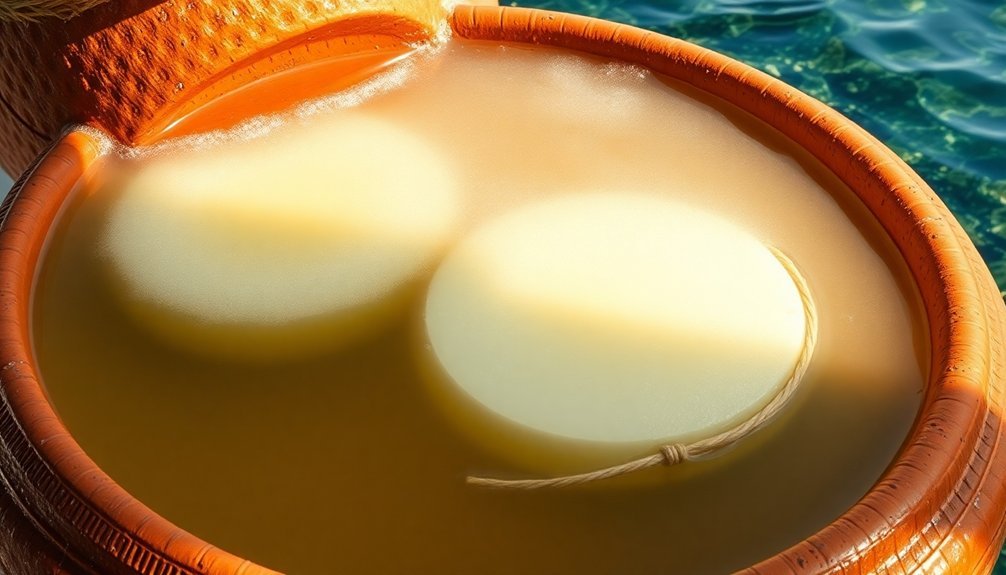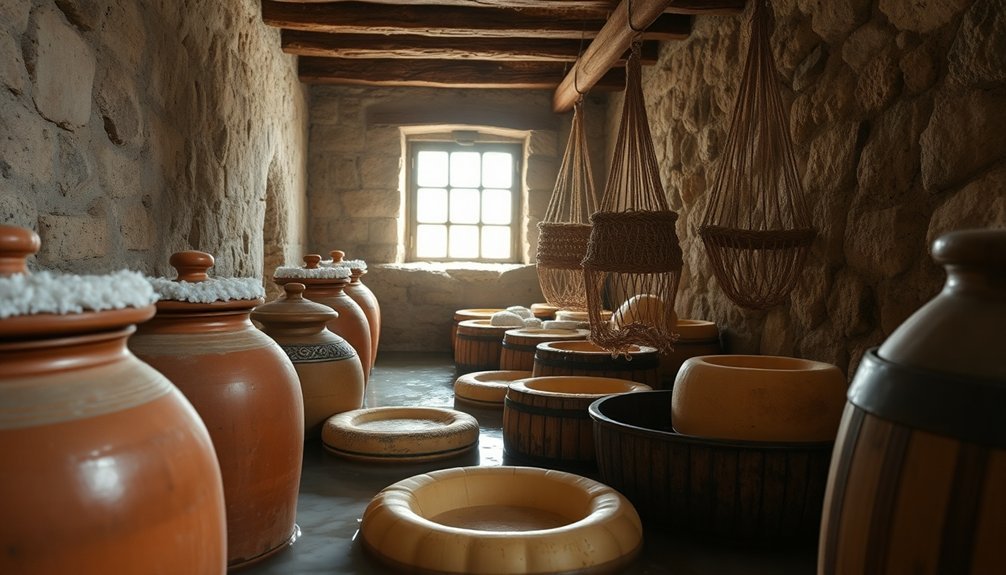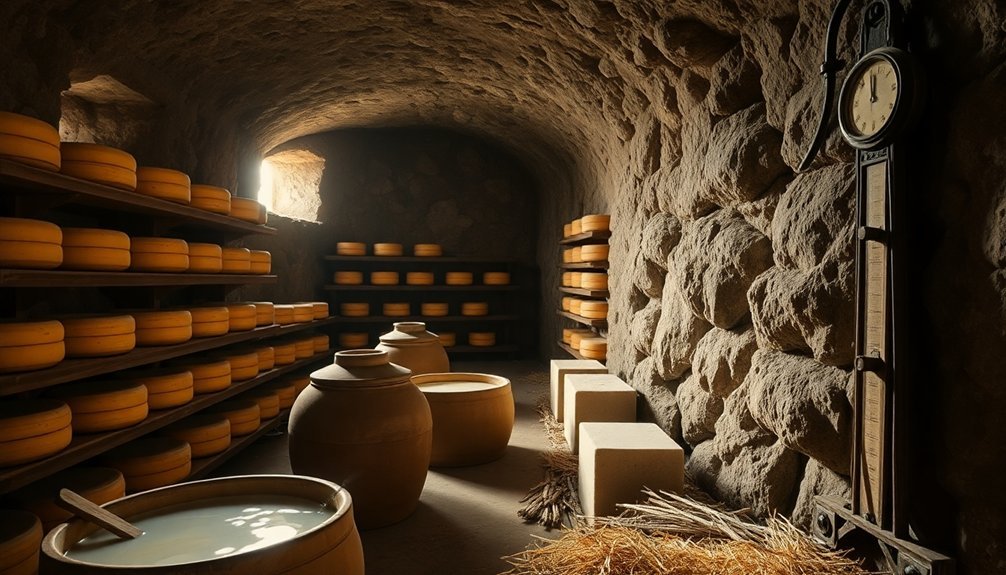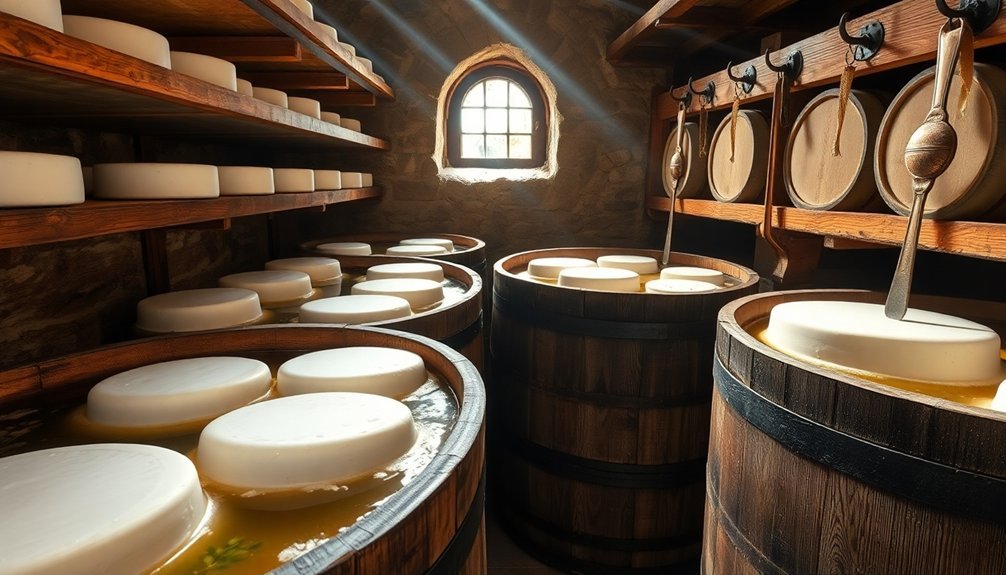Old-world cheese brining relies on pure, non-iodized salt and traditional vessels like ceramic pots or wooden barrels. You'll find ancient Mediterranean methods called for seawater's natural 3.5% salinity, while later techniques developed precise 26.5% brine concentrations. European cheesemakers mastered temperature control using mountain caves and cellars, maintaining ideal conditions between 50-55°F (10-13°C). You'll need cheesecloth and weights to keep your cheese fully submerged, just as artisans did centuries ago. These time-tested practices stretch back to 1200 BCE, when maritime trade spread cheesemaking across civilizations – and there's so much more to discover about this ancient craft.
Ancient Mediterranean Brining Methods

In the ancient Mediterranean, cheesemaking techniques evolved through centuries of maritime trade and cultural exchange. By 1200 BCE, during the late Bronze Age, these methods had spread extensively throughout the region, with Greek and Roman civilizations adopting and refining earlier practices, particularly in the production of brined, feta-style cheeses. Columella's writings detailed how thin cheese needed quick brining while thicker varieties required longer salt bath times.
You'll find that ancient cheesemakers were quite resourceful in their brining methods. They'd often use seawater, which naturally contains about 3.5% salt, to separate curds and create the initial salination.
When you're making cheese using these traditional techniques, you'll notice that the brine serves multiple purposes: it firms the cheese without lengthy aging, prevents harmful bacteria, and develops the distinctive rind.
The brining process you'd use depends on the specific cheese type. You can apply brine as a soak, spray, or wash, with soaking times ranging from hours to days.
After pressing your cheese, especially for harder varieties, you'll need to submerge it in the brine solution. This process creates an ion exchange where sodium and chloride move into the cheese while water moves out, affecting both texture and ripening.
Traditional Salt Selection
When selecting salt for traditional cheese brining, you'll need to choose between pure sodium chloride varieties that match centuries-old practices.
Traditional cheesemakers prioritize salts without additives, often selecting unrefined or sea salt for ideal flavor profiles. The use of non-iodized salt is essential to prevent unwanted chemical reactions during aging. You'll find that fine salt dissolves more readily in brine solutions, though both fine and coarse varieties can work effectively.
For firmer cheeses, you'll want to take into account adding calcium chloride to your salt mixture to improve texture and maintain proper calcium balance.
When preparing your brine, you should boil the water first to eliminate impurities, then cool it to room temperature before gradually adding salt. You'll know you've reached saturation when no more salt dissolves, typically around 26.5% concentration at room temperature.
Store your brine solution in non-reactive containers at 50-55°F (10-13°C) to maintain its effectiveness.
You'll need to monitor the pH levels regularly, aiming for 5.4-4.9 pH to match your cheese. While you can reuse brine, don't keep it above 60°F for extended periods.
Remember to adjust salt concentrations based on your specific cheese type, using 10% for light brine or 20% for medium brine solutions.
Historical Brining Vessels

The ancient art of cheese brining relied heavily on specialized vessels that evolved across civilizations. You'll find that ceramic and clay pots were the most common materials, with their excellent durability and natural insulating properties.
These vessels often featured strategic holes and perforations to help drain whey from the curd during the cheese-making process. Cheesemakers would typically seal the vessels with lard or butter to maintain optimal preservation conditions. If you'd explored the Mediterranean region during ancient times, you'd have seen ceramic vessels used extensively for both cheese production and trade.
In European traditions, wooden containers and clay pots dominated the landscape. To maintain proper temperature control, cheesemakers would often bury their vessels underground, especially in warmer climates.
The vessels weren't just simple containers – they required careful maintenance and preparation. You'd need to clean them thoroughly and sometimes line them with cloth or animal fat before use.
During the brining process, you'd have to monitor the brine solution regularly and apply pressure using weights or beams to achieve the desired results. This technique spread globally through various channels, including Swiss immigrants who brought their methods to places like Wisconsin, adapting their traditional vessel designs to locally available materials.
European Cave Aging Practices
Mastering the art of cave aging requires specialized environments that European cheesemakers have perfected over centuries. You'll find these aging facilities in natural caves, mountain cellars, and even repurposed railway tunnels, where temperature, humidity, and air movement are carefully controlled.
If you're aging Swiss-style cheeses like Gruyere or Emmentaller, you'll need multiple rooms with different temperature settings. You'll start in warm rooms at 70°F to develop the characteristic eyes, then move the cheese to cooler 55°F environments for final aging. This multi-room approach, while challenging, guarantees consistent quality through cooperative aging systems.
In Italy, you'll discover unique traditions like Formaggio di Fossa, where cheese ages in straw-lined pits. Before aging begins, you'll need to sterilize the pit by burning straw, then carefully stack the cheese wheels and seal the pit with wood, sand, and plaster.
Professional affineurs manage these aging environments with precision, performing essential tasks like washing, turning, and piercing the cheese.
Whether you're using traditional caves or modern walk-in refrigerators, you'll need to calibrate conditions specifically for each cheese type you're aging.
Regional Temperature Control Techniques

You'll find remarkable temperature control methods across Europe's traditional cheese-making regions, from Mediterranean caves that maintain natural cool temperatures to Nordic ice rooms that preserve precise climate conditions.
In Alpine regions, you'll discover cellar systems that leverage natural mountain air circulation to achieve ideal brining temperatures between 7-10°C.
These time-tested regional approaches demonstrate how different cultures have adapted their brining practices to local climates while maintaining consistent cheese quality.
Mediterranean Cool Cave Storage
Successfully aging cheese in the Mediterranean region presents unique challenges due to the hot, humid climate. To counter these conditions, you'll need to maintain temperatures between 50-55°F (10-13°C) and control humidity levels at 70-99%. Natural cave systems provide ideal environments for cheese aging, as they naturally regulate both temperature and moisture.
| Storage Type | Benefits | Challenges |
|---|---|---|
| Natural Caves | Consistent temp & humidity | Limited availability |
| Cellar Storage | Cost-effective cooling | Requires monitoring |
| Climate Control | Precise adjustments | Higher energy costs |
When you're setting up your cave storage, you'll need to monitor the environment carefully using digital hygrometer thermometers. Place your brined cheese in large glass jars or food-grade plastic containers, making sure to separate layers with parchment paper. You'll want to weight the cheese to keep it submerged in the brine solution, which should be maintained at the same cool temperature as the cave. If you're using a natural cave system, you'll still need to check for proper ventilation to prevent excessive moisture buildup and unwanted mold growth. Remember to maintain your brine solution at 21-23% salt concentration for best results.
Nordic Ice Room Methods
Traditional Nordic ice room methods rely on precise temperature control to achieve ideal cheese brining results. You'll need to maintain temperatures between 7°C to 10°C (45°F to 50°F) during the brining process, which guarantees peak salt uptake while preventing unwanted structural changes in your cheese.
When you're working with Nordic ice room techniques, you'll find that temperature consistency is vital. For every pound of cheese, you'll need to brine for approximately two hours, making sure to flip the cheese halfway through if it floats.
You can lower temperatures to 2°C to 7°C (35°F to 45°F) when you're focusing on cooling the cheese and controlling microbial growth.
To maintain quality, you'll need to monitor your brine system regularly. Check the temperature, salinity, and calcium levels, especially if you're reusing the brine.
While higher temperatures can increase salt absorption, they'll also raise the risk of microbial issues. For the maturation and ripening phases, you'll want to keep temperatures between 6°C to 12°C (43°F to 54°F).
This temperature range has proven effective in traditional Nordic cheese-making facilities for generations.
Alpine Cellar Temperature Control
Precision defines Alpine cellar temperature control, where maintaining consistent temperatures between 50-55°F (10-13°C) is essential for perfect brining results.
You'll find that traditional Alpine cheese makers have mastered the art of temperature regulation through careful cellar design and natural cooling methods, guaranteeing their brines maintain prime conditions for salt absorption.
When you're working with Alpine-style temperature control, you'll need to monitor three critical factors:
- Temperature stability – Keep your cellar within the 50-55°F range, as fluctuations can lead to uneven salt distribution and inconsistent results.
- Air circulation – Guarantee proper ventilation while maintaining temperature, which helps prevent cheese from darkening or developing surface issues.
- Humidity balance – Maintain levels between 70-99%, adjusting based on your cellar's temperature.
You'll notice that warmer temperatures speed up salt absorption and microbial activity, while cooler temperatures slow these processes down.
To achieve the best results, you should check your cellar's temperature multiple times daily and make adjustments as needed.
This careful monitoring reflects the traditional Alpine approach, where cheese makers relied on natural cave systems and seasonal variations to maintain perfect conditions.
Heritage Submersion Tools
The art of cheese brining relies heavily on time-tested submersion tools that have remained largely unchanged for generations.
You'll find that traditional vessels like mason jars and wooden barrels continue to serve as fundamental equipment for creating properly brined cheese, provided they're thoroughly sterilized before use.
To achieve ideal submersion, you'll need to employ cheesecloth and appropriate weights to keep your cheese fully covered by the brine solution.
These tools guarantee even contact between the cheese and brine, preventing uneven salt absorption. Before you begin the brining process, you'll want to use cheese molds and presses to properly shape and prepare your cheese.
During the brining process, you'll need to store your cheese in the refrigerator to maintain the perfect temperature range of 50-55°F (10-13°C).
This controlled environment helps regulate salt absorption rates and prevents spoilage.
Once you've completed the brining process, it's vital to allow your cheese to air dry before moving on to aging or packaging.
This final step helps develop a proper dry surface and sets the stage for successful aging.
Frequently Asked Questions
How Did Ancient Cheesemakers Test Brine Concentration Without Modern Measuring Tools?
You'd test brine concentration by floating an egg or vegetable in the solution. If it floated at the right height, you'd know the salt content was correct for cheese brining.
What Natural Materials Were Traditionally Used to Weight Cheese During Brining?
You'll find that traditional cheesemakers used cleaned natural stones, wooden presses, ceramic plate weights, and food-grade metal weights to keep their cheese submerged during brining, ensuring even salt distribution throughout the aging process.
Did Seasonal Changes Affect Traditional Brining Practices Across Different Cultures?
Yes, you'd find that cultures adjusted their brining practices seasonally. They'd use stronger brines in summer to combat faster aging, while winter allowed longer brining times due to naturally cooler temperatures.
How Were Brine Solutions Traditionally Filtered and Purified Before Modern Technology?
You'd filter brine through cheesecloth to remove large particles, then manually skim off floating fats and proteins. Boiling the water beforehand helped purify it, while settled solids were regularly removed from tank bottoms.
What Indigenous Herbs Were Historically Added to Cheese Brines for Preservation?
You won't find historical evidence of indigenous herbs being added to cheese brines for preservation. Traditional cheese brining relied solely on salt content and natural microbial processes, not herbal additions, to preserve the cheese.
In Summary
You'll find that old-world cheese brining techniques remain relevant today. Whether you're using Mediterranean sea salt, traditional clay vessels, or European cave aging methods, these time-tested practices produce exceptional results. By controlling temperature and using heritage tools like wooden submersion racks, you're connecting with centuries of artisanal cheese-making wisdom. These ancient methods continue to influence modern brining practices.





Leave a Reply